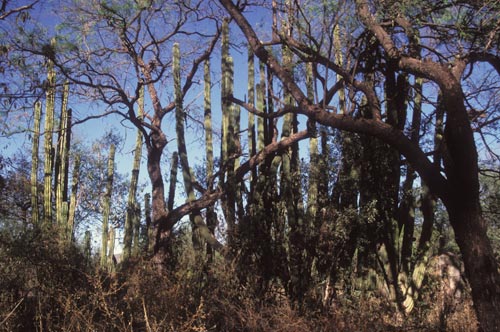Sonoran Desert & Sinoloan Deciduous Forest
Last modified: January 2, 201859… Cactus and trees side by side in perfect harmony…
The Sonoran Desert and Sinaloan deciduous forest coexist in Álamos and surroundings
hills. They both are evolving products of a climate that over the past millions of years
has become more arid. The desert plants to the north have become accustomed to frost
and less rainfall and the deciduous forest, already adapted to less rainfall, continues
to adapt to the changing climate. The Sonoran Desert is a dry tropical forest, desert
bushes near the border are trees in Álamos.
Organ pipe cactus, competing for light, tower up above the dense canopy fueled
by summer monsoons. During the dry spring most of these plants lose their
leaves and a jungle becomes a brown stick forest with the only green being
columnar cactus. The Sinaloan deciduous forest includes mesquite, hopbush,
palo verdes, elephant trees, fig trees, orchids, bromeliads, lianas, acacias,
palo blanco, octillo trees, Sonoran guava, torotes, palo fierro, brasil, Montezuma
cypress, frangipani, amapa, kapk, octopus agaves, epiphytes and… Diversity
abounds in this short tree forest with canopies on average twenty feet high.
The morning humidity is comfortable, a refreshing air shower punctuated by
cries, songs and calls of mammals, birds and insects… In the distance one
can hear the sounds of people moving across Álamos: a car’s brakes, a bus
starting up, a school bell, voices hitch hiking great distances on summer breezes…
As one looks down from Red Cross Hill on what was once a foothold,
and support base, for Spaniards moving north to colonize the southwest
one wonders has this summer view of the church and plaza, through a small
window within abundant flora, changed much since the 1800’s?
View from Above
Mt. Álamos is some 6,500 feet above sea level. It towers 5,000 feet above the town
of Álamos. It is another world, wild parrots, dry tropical forest, granite and…
Up and down is a day’s effort, it is well worth it. To reach the top it is
recommended to start hiking early while it is still dark and cool. Photos
and editing by Anders Tomlinson. Music from “Camino Songs” by SonicAtomics.
To the east, the Cuchujaqui River is a nearby Álamos summer getaway.
The Cuchujaqui River is to the east of Álamos, Sonora, Mexico. Three arroyos
join together in Álamos and flow to the Cuchujaqui River, on to the El Fuerte
River and ultimately the Pacific Ocean. It is a cooling retreat for Álamos
folks especially in the hot summer. On this day, Antonio, an Álamos dentist,
spear-fished one bass, a couple of catfish and many carp.
A good time was had by all.
Here was Silver
Here, seven miles west of Álamos, at 2,500 feet elevation with surrounding
mountains as high as 4,700 feet, Aduana has a few hundred people where once
there was 5,000. A church, country store, cemetery, a small restaurant-inn,
a plaza with a dry fountain in its center are surrounded by the past. Spanish
conquistador Vasquez de Coronado camped here during the winter of 1540-41. He
was searching for gold in what turned out to be mountains with veins of silver.
The mines closed in 1906 after nearly 400 years of continuous mining. La Aduana
was the “custom office”, it was all about taxes and royalties. Photos and
editing by Anders Tomlinson. Music from “Camino Songs” by SonicAtomics.
Time stands still: a river moves on and letter-press printing continues.
Two days before Christmas 1993 the film crew travels out to the Rio Cuchujaqui.
It is a world unto itself but not that far away from Álamos. And then we visit
a print shop that has been in operation for over 100 years. Álamos had
the first printing press in the Californias. One wonders if these presses are
still at work. Letter presses have an imprint-edge that can be felt with
the fingers and the soul.
To see more Álamos Journal pages.
To return Home.
©2013 Anders Tomlinson, all rights reserved.









